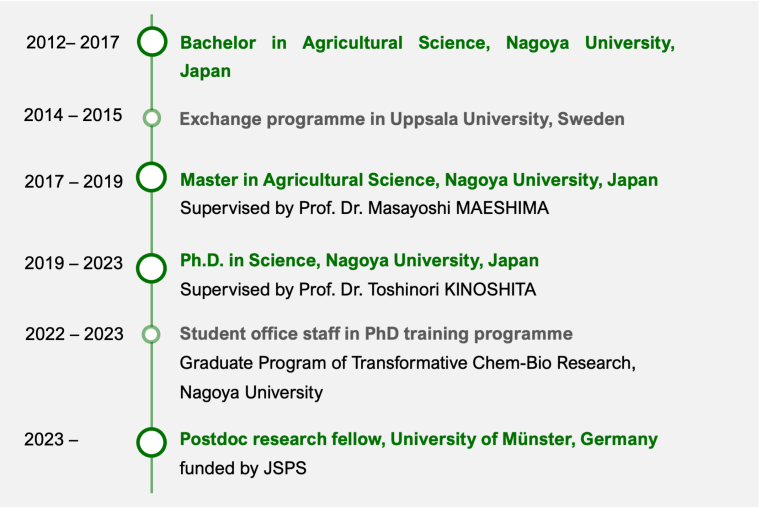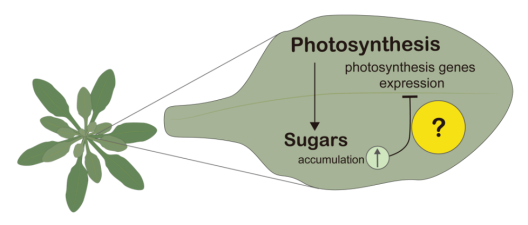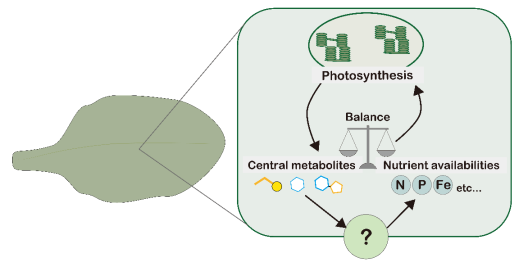
Satoru Naganawa-Kinoshita received his PhD in Science from Nagoya University (Japan) in 2023 under the supervision of Prof. Toshinori Kinoshita. During his PhD, he was awarded a research fellowship for young scientists (DC1) from Japan Society for the Promotion of Science (JSPS). During his PhD, he found that the products of photosynthesis, photosynthates trigger the activation of plasma membrane H+-ATPase, an engine of plasma membrane transport systems, and facilitate the uptake of nitrate into leaves, illustrating the relationship between photosynthates and the maintenance of nutrient availability in leaves. After his PhD, he was awarded overseas research fellowship from JSPS to work on the elucidation of molecular mechanism of sugar-driven photosynthesis suppression in Arabidopsis at the current institute, IBBP in Universität Münster (Germany), with Prof. Iris Finkemeier. He is currently investigating the molecular mechanism of sugar-driven suppression on photosynthesis or vegetative growth of plants. With the novel insights from the study, his goal is to suggest a venue to increase the biomass of agronomically important plants with the biotechnological approach.

Achievements & Grant funding
2019 – 2022 Research grant for young researchers
from Grants-in-Aid for Scientific Research, Japan.
March 2023 IWPMB2023 travel fellowship
at International Workshop on Plant Membrane Biology 2023, Taiwan.
April 2023 ITbM research award
from Institute of Transformative Bio-Molecules, Nagoya University
April 2023 – Postdoctoral oversea research fellowship
from JSPS
Research topic:
Central metabolites control plant photosynthesis and growth.
With the illumination, plant convert atmospheric CO2 into the divergent central metabolites. The process is consisting of complex enzymatic reactions and is called photosynthesis. Plants are monitoring the content of central metabolites and adjust the reaction of photosynthesis, metabolism, or nutrient acquisition. We are especially interested in the response of plants to the endogenous content of central metabolites to control plant photosynthesis and growth. We aim to elucidate the molecular mechanism of two phenomena: 1) Sugar-driven suppression of photosynthesis; 2) Maintenance of balance between carbon metabolites and nutrients.

1) “Sattheit” of plants: how plants cope with high carbon metabolites contents in leaves?
The accumulation of sugars produced via photosynthesis suppress the expression of photosynthesis-related genes. To dissect the mechanism, we recently developed the genetic material that accumulate sugars endogenously in the leaves. With the forward genetic and multi-‘omics approach including proteomics and metabolomics, we aim to identify the pivotal molecular networks that suppress the photosynthesis under high sugar accumulation in leaves.

2) How central metabolite balances nutrient availabilities to control photosynthesis performance in plant leaves?
Nitrate is a form of nitrogen, and an essential nutrient for regulating the photosynthesis performance in leaves. Previously we illustrated that the products of photosynthesis promote the nitrate uptake into the cells in leaves via activating plasma membrane H+-ATPase, an engine of plasma membrane transport systems. Like the case of nitrate, central metabolites-driven activation or suppression of transporter proteins may influence the divergent transports of nutrients that control the photosynthesis performance. Thus, we are interested in the mechanism how central metabolites balance the nutrient availabilities to regulate the photosynthesis performance in leaves.
